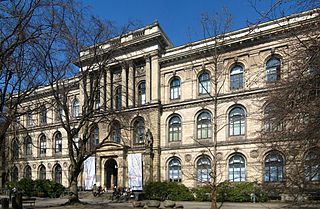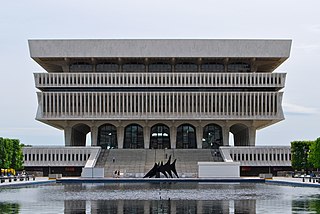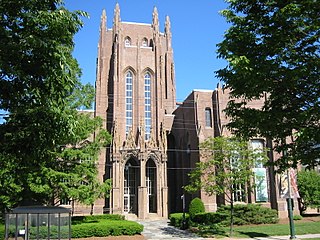
The Natural History Museum in London is a museum that exhibits a vast range of specimens from various segments of natural history. It is one of three major museums on Exhibition Road in South Kensington, the others being the Science Museum and the Victoria and Albert Museum. The Natural History Museum's main frontage, however, is on Cromwell Road.

Bulawayo is the second largest city in Zimbabwe, and the largest city in the country's Matabeleland region. The city's population is disputed; the 2022 census listed it at 665,940, while the Bulawayo City Council claimed it to be about 1.2 million. Bulawayo covers an area of about 546 square kilometres in the western part of the country, along the Matsheumhlope River. Along with the capital Harare, Bulawayo is one of two cities in Zimbabwe that is also a province.

The Field Museum of Natural History (FMNH), also known as The Field Museum, is a natural history museum in Chicago, Illinois, and is one of the largest such museums in the world. The museum is popular for the size and quality of its educational and scientific programs, and its extensive scientific specimen and artifact collections. The permanent exhibitions, which attract up to 2 million visitors annually, include fossils, current cultures from around the world, and interactive programming demonstrating today's urgent conservation needs. The museum is named in honor of its first major benefactor, Marshall Field, the department-store magnate. The museum and its collections originated from the 1893 World's Columbian Exposition and the artifacts displayed at the fair.

The National Museum of Natural History is a natural history museum administered by the Smithsonian Institution, located on the National Mall in Washington, D.C., United States. It has free admission and is open 364 days a year. In 2021, with 7.1 million visitors, it was the eighteenth most visited museum in the world and the second most visited natural history museum in the world after the Natural History Museum in London. Opened in 1910, the museum on the National Mall was one of the first Smithsonian buildings constructed exclusively to hold the national collections and research facilities. The main building has an overall area of 1.5 million square feet (140,000 m2) with 325,000 square feet (30,200 m2) of exhibition and public space and houses over 1,000 employees.

Manchester Museum is a museum displaying works of archaeology, anthropology and natural history and is owned by the University of Manchester, in England. Sited on Oxford Road (A34) at the heart of the university's group of neo-Gothic buildings, it provides access to about 4.5 million items from every continent. It is the UK's largest university museum and serves both as a major visitor attraction and as a resource for academic research and teaching. It has around 430,000 visitors each year.

The Museum of Natural Sciences of Belgium is a museum dedicated to natural history, located in Brussels, Belgium. The museum is a part of the Royal Belgian Institute of Natural Sciences. Its most important pieces are 30 fossilised Iguanodon skeletons, which were discovered in 1878 in Bernissart, Belgium.

The Natural History Museum is a natural history museum located in Berlin, Germany. It exhibits a vast range of specimens from various segments of natural history and in such domain it is one of three major museums in Germany alongside Naturmuseum Senckenberg in Frankfurt and Museum Koenig in Bonn.

Eastern New Mexico University is a public university with a main campus in Portales, New Mexico, and two associate degree-granting branches, one at Ruidoso and one at Roswell. ENMU is New Mexico's largest regional comprehensive university and is the most recently founded state university in New Mexico. It is a federally designated Hispanic-serving institution and a member of the Hispanic Association of Colleges and Universities. The ENMU System consists of three campuses. The current Chancellor is Dr. James N Johnston who assumed office in 2022.
The Western Australian Museum is a statutory authority within the Culture and the Arts Portfolio, established under the Museum Act 1969.
The Natural History Museum of Utah (NHMU) is a museum located in Salt Lake City, Utah, United States. The museum shows exhibits of natural history subjects, with an emphasis on Utah and the Intermountain West. The mission of the museum is to illuminate the natural world and the place of humans within it. A new building, named the Rio Tinto Center, opened in November 2011. The museum is part of the University of Utah and is located in the university's Research Park.

The Natural History Museum at Tring was the private museum of Lionel Walter, 2nd Baron Rothschild; today it is under the control of the Natural History Museum, London. It houses one of the finest collections of stuffed mammals, birds, reptiles and insects in the United Kingdom. It was known as the Walter Rothschild Zoological Museum until April 2007. The museum is located on Akeman Street, in Tring, Hertfordshire.

The New York State Museum is a research-backed institution in Albany, New York, United States. It is located on Madison Avenue, attached to the south side of the Empire State Plaza, facing onto the plaza and towards the New York State Capitol. The museum houses art, artifacts, and ecofacts that reflect New York’s cultural, natural, and geological development. Operated by the New York State Education Department's Office of Cultural Education, it is the oldest and largest state museum in the US. Formerly located in the State Education Building, the museum now occupies the first four floors of the Cultural Education Center, a ten-story, 1,500,000-square-foot (140,000 m2) building that also houses the New York State Archives and New York State Library.

The Gallery of Mineralogy and Geology is a part of the French National Museum of Natural History. It is situated in the Jardin des plantes in Paris near the gare d'Austerlitz train station. The gallery displays a collection of crystals, gemstones and minerals parmi les plus anciennes et les plus prestigieuses du monde.
The Georgia Museum of Natural History is the U.S. state of Georgia's museum of natural history located in Athens, Georgia. The museum has eleven different collections in Anthropology, Arthropods, Botany, Geology, Herpetology, Ichthyology, Invertebrate, Mammalogy, Mycology, Ornithology, and Zooarchaeology. In addition, there are exhibitions, archives, and entertainment for children. The Exhibit Gallery is free and open to the public during scheduled hours. People can schedule a tour to visit the collections by appointment.

The New Jersey State Museum is located at 195-205 West State Street in Trenton, New Jersey. The museum's collections include natural history specimens, archaeological and ethnographic artifacts, and cultural history and fine art objects. Exhibitions, educational activities, research programs, and lectures are also offered. The museum, a division of the New Jersey Department of State, includes a 140-seat planetarium and a 384-seat auditorium.

The University of Michigan Museum of Natural History is a natural history museum of the University of Michigan in Ann Arbor, Michigan, United States.

The Peabody Museum of Natural History at Yale University is one of the oldest, largest, and most prolific university natural history museums in the world. It was founded by the philanthropist George Peabody in 1866 at the behest of his nephew Othniel Charles Marsh, an early paleontologist. Most known to the public for its Great Hall of Dinosaurs, which includes a mounted juvenile Brontosaurus and the 110-foot-long (34 m) mural The Age of Reptiles. It also has permanent exhibits dedicated to human and mammal evolution; wildlife dioramas; Egyptian artifacts; and the birds, minerals, and Native Americans of Connecticut.
The following is a timeline of the history of the city of Bulawayo, Zimbabwe.
Michael Patrick Stuart Irwin was a British-Rhodesian ornithologist.















